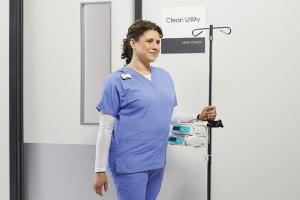Functional flooring designed for health care facilities
The best hard-flooring products in hospitals today offer solutions to enhance not only floor performance, but the performance of the space as a whole — including safety, comfort, acoustics, mobility, maintenance, infection control, aesthetics and cost of ownership. These features are incorporated into many of the latest hard-flooring products.
However, the health care environment poses many challenges to manufacturers. With reimbursement protocols shifting, the challenge to provide cost-effective flooring solutions while maintaining key performance attributes is ever-present. Patient satisfaction is a key driver for measurement and reimbursement, so improving overall satisfaction through noise reduction, a clean appearance, and colors and patterns that support a healing environment is mandatory.
You may also like |
| Designing a hospital floor cleaning program |
| Hard flooring designed for health facilities |
| Advances in floor cleaning equipment |
|
|
Manufacturers are challenged with providing flooring that satisfies the complex demands of a hospital, where a variety of functions takes place under one roof. Lobbies and corridors require durable flooring that stands up to heavy foot traffic and rolling loads, while stain resistance to multiple substances — including chemicals and disinfectants — is important in treatment spaces, emergency departments, laboratories and operating suites.
Factors in flooring selection
Only a small percentage of a hospital’s construction budget is associated with flooring. However, with the high level of wear and tear to which floors are subjected, it is imperative that the right floor is installed in the right space, experts agree. Ease of maintenance to sustain that clean, new look and installation (both initial and repair) are key considerations when selecting the right product.
Facilities managers need to examine a variety of factors when selecting hard flooring. Material cost, including installation and any initial flooring preparation prior to use, should be considered as the installed price, according to Daniel Collins, director of health care markets, Shaw Contract, Cartersville, Ga. “The cost of maintaining the floor to an acceptable level also should be considered. This cost should include cleaning chemicals, required machinery, frequency of cleaning as well as any downtime experienced for routine cleaning,” he says.
A flooring material’s Taber score, which measures the abrasion resistance of protective floor finishes, should be taken into account as well as FloorScore certification, which rates the flooring material’s contribution to improved indoor-air quality. FloorScore was developed by the Resilient Floor Covering Institute.
During the selection process, the obvious question is: How will the product perform in a 24/7 environment that is demanding, requires sanitary conditions and contributes to people's health. But maybe a different perspective should be considered, says Mark Huxta, director of sales for health care, Ecore, Lancaster, Pa.
“Perhaps it’s really a question of what can a floor deliver? The paradigm shift is to go beyond our traditional perception of what a floor should do and ask, ‘How can a floor impact people — patients, residents and staff?’ At that point, the selection takes on a whole new orientation and purpose, one that is truly based on patients’ experience and outcomes.”
Next-level trends
Recent trends in hard flooring are aimed at improving safety, cleanability and appearance. From a design standpoint, there are more patterns, colors, shapes and sizes that give designers the tools and flexibility to tailor interiors to specific needs of hospitals and patients. In addition, technology is enabling greater performance from flooring products.
“Beyond improved durability, stain resistance and easier maintenance, performance factors such as acoustic control or cushioning (for safety and comfort underfoot) increase patient satisfaction,” says Ridley Kinsey, director of health care markets, Patcraft, Dalton, Ga.
Luxury vinyl tile (LVT) is becoming more common for use in hospital areas that do not require heat-welded seams and self-coving sheet goods, according to Collins. “This product category provides users with ease of cleaning,” he says. “Wax is optional, which reduces the need for costly maintenance equipment associated with vinyl composition tile (VCT) flooring.”
Wayfinding in flooring designs is becoming more popular as it helps to guide residents and patients around complex hospital buildings. This may be due to the fact the many people simply look down at their cellphones. “Custom compass motifs inlaid into the floors are being specified; even themed floors in specific children areas are being requested,” says Paul Eanes, vice president of sales, Metroflor Corp., Norwalk, Conn.
The human element of health care is coming to the forefront as many hospitals are warming up previously sterile environments to make them feel more like home — especially in palliative care, long-term care, maternity and pediatrics.
To meet that need, Metroflor has introduced a 46-part collection called Aspecta One, which is designed for the health care sector. These designs “pop” with bright, cheery colors that create an environment conducive to healing. Aspecta One is a no-wax floor treated with a ceramic bead finish that translates to maximum wear performance, the company reports.
ColorArt homogeneous sheet flooring from Armstrong Commercial Flooring, Lancaster, Pa., is designed to provide attractive, easy-to-clean, long-lasting floors. “Thanks to patent-pending Diamond10 Coating Technology, ColorArt offers high scratch-, stain- and scuff-resistance along with a spectrum of colors that provide a clean, fresh appearance, assistance in wayfinding and the ability to create comfortable, engaging spaces,” says James Johnson, commercial segment manager.
Safety is another important factor in new hard-flooring designs. For example, Safety Zone Sheet from Armstrong Commercial Flooring provides a through-pattern construction in a dense, de-aerated formulation for long-lasting safety resistance under high-traffic conditions. “Safety Zone offers dynamic underfoot safety, activating when compressed to supply sure-grip texture underfoot. The through-pattern wear layer construction means the slip-retardant performance will not wear off,” Johnson explains.
The compatibility of Safety Zone Sheet with Armstrong linoleum, homogeneous and heterogeneous sheet products means that designers and building owners can integrate safety flooring into key areas without compromising the overall design intent of the space. In addition, Safety Zone is available in a tile format for increased installation options.
Acoustics is another important feature of new hard-flooring products. Solitude, a new LVT collection from Shaw Contract, features stone and wood visuals with light embossing and squared edges for a natural appearance that is easily cleaned. Solitude incorporates a silencing layer to reduce sound transfer without the use of underlayment. The product is securely glued to the floor to withstand the demands of rolling traffic. In addition, it can be installed adjacent to most carpet without the use of transition strips or reducers.
Sustainable path
Patcraft has introduced AdMix, a homogeneous resilient tile that combines durability (2,500 psi) with stain resistance and the appearance of terrazzo. Its coefficient of friction qualifies AdMix as a safety (nonslip) floor, and its low-maintenance requirements offer an easy-care option for flooring in high-traffic areas. From a green perspective, AdMix is created using 10.4 percent recycled content and emits lower volatile organic compounds (VOCs) than linoleum and rubber, the company reports.
Tarkett USA Inc., Solon, Ohio, has developed iQ One, a non-PVC sheet and tile product that never needs a floor finish coating, according to Chad Bittner, director of product management and marketing–health care and education. Simple maintenance consists of a soap and water rinse with dry buffing as needed. “The product lowers maintenance costs, enabling health care facilities to reduce the total cost of ownership over the course of its lifecycle,” he says.
The Stonhard Group, Maple Shade, N.J., offers the Fritztile Vibrant Pearl Collection, which combines natural stone chips with mother of pearl in an opaque, high-performance matrix. “The secret to Fritztile’s durability lies in the polyester resins used, which gives the tile a gentle flexibility, leaving it more resistant to cracking and shattering,” says Randy Gillespie, vice president of marketing and sales. The product offers acoustic advantages as well because the polyester resin in Fritztile doesn’t set in a rigid structure like concrete or epoxy. This prevents sounds waves from transferring through or bouncing off the floor.
Hospital facilities managers are looking for flooring products that are easy to maintain, support a hygienic environment and minimize disruption to patients. Thus, many are turning to rubber flooring to meet these challenges, according to Tim Cole, vice president of marketing at nora systems, Inc., Salem, N.H.
“That’s because premium rubber flooring does not require sealants, wax or other coatings to maintain its original appearance. It can be easily cleaned, in some cases with just water, which means patients do not need to be moved nor large areas of the hospital closed while wax is stripped, reapplied and allowed to dry,” Cole says.
Premium rubber flooring’s dense, nonporous surface repels dirt and stands up to spills without absorbing them, he adds. It also provides slip resistance, which is important to creating a safe environment for patients, visitors and staff.
nora systems Inc. has developed noraplan valua floor covering, which offers a tranquil color palette of 32 nature-inspired hues (in two design options) with varying degrees of contrast and a seamless natural texture. “Available in sheet and plank, the floor covering lends itself to a variety of applications in health care settings,” Cole says.
Ecore has developed Galaxy rx, which is suitable for sterile environments. The surface features premium rubber sheet flooring fusion-bonded to a recycled rubber backing. The company also offers Terrain rx and Forest rx, which feature a vinyl surface fusion-bonded to a recycled rubber backing.
“As a result, both products are able to reduce the force of impact by up to 35.5 percent, compared with traditional resilient flooring products. They also offer acoustic properties that deliver a quiet, healing environment, while still providing indentation recovery and support for heavy rolling traffic associated with inpatient areas,” Huxta says.
Finally, do flooring features differ between small off-site facilities and large hospitals?
Yes and no, says Johnson. “With wayfinding being an important design element in large acute care facilities, there may be more focus on designs and colors that coordinate across product categories. In addition, large hospitals need hard flooring products that perform in a variety of spaces.
“Each space has its own performance requirements, calling for coordinating products across a variety of sheet and modular floor options,” Johnson notes. “In a small off-site ambulatory space, wayfinding is not as critical, but evidence-based design still necessitates the use of warm, welcoming designs that do not feel institutional and the right products to fit each space's performance attributes and needs.”
Localized, small medical office buildings are the fastest growth segment in health care, as far as LVT flooring is concerned, according to Eanes. “Along with the never-ending demand for assisted-living facilities, this segment is a perfect match for resilient hard flooring, especially LVT, to maximize design.”
Continued innovation
Looking ahead, manufacturers of hard flooring will continue to innovate with a focus on healthy materials that are durable, stain resistant and designed for easy cleaning in health care environments, according to Bittner. Improving indoor-air quality will continue to be a major focus within this market segment as well.
Johnson agrees that green trends in hard flooring will continue. “The growing need and desire for Lean building and remodeling practices will drive the use of natural, renewable and recycled flooring content,” he says. “Environmental certifications and incentives, such as LEED accreditation, will continue to affect facility designs and how maintenance is managed."
Neal Lorenzi is a freelance writer based in Mundelein, Ill.
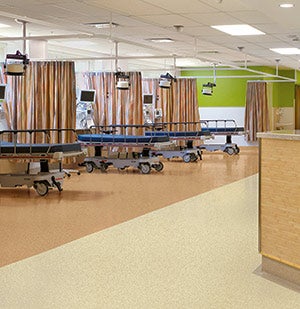
Subtle contrast
ColorArt Medintech Carthamus Champagne and Sandalwood is installed in the emergency department of Abbotsford Regional Hospital, British Columbia. Armstrong Commercial Flooring www.armstrong.com/commflooringna/

Patient safety
Force-reduction tests have shown that fall impact is reduced 16.9 percent when Forest rx is installed. Ecore www.ecorecommercialflooring.com

Peaceful care
Aspecta Ten offers a waterproof, sound-mitigating LVT flooring option for health care facilities. Metroflor Corp. www.metroflorcorp.com
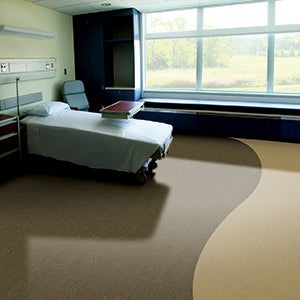
Green ground
Nature-inspired noraplan valua, a sustainable floor covering, is available in sheets and planks. nora systems Inc. www.nora.com/us/
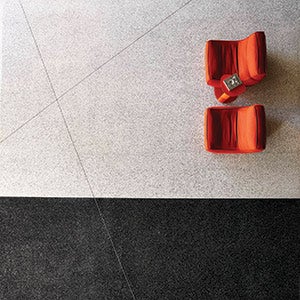
All in one
AdMix, a homogeneous resilient tile, combines durability, stain resistance and the appearance of terrazzo. Patcraft www.patcraft.com
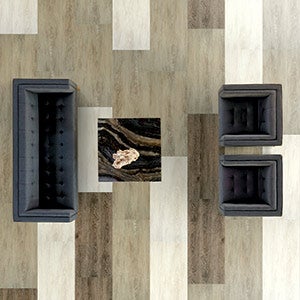
Blending in
Solitude LVT is a collection of wood visuals in subtle shades of embossed grain textures from light to medium for realistic appearance. Shaw Contract www.shawfloors.com
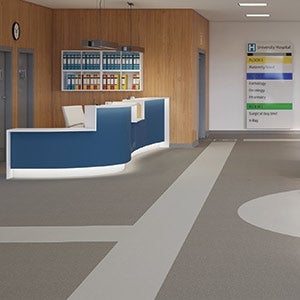
Smart solution
iQ ONE’s non-PVC formula balances aesthetics, flexibility and strength. Tarkett USA Inc. www.tarkett.com




